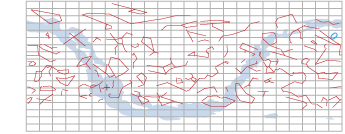
Maraille: A D&D idea stack | ||
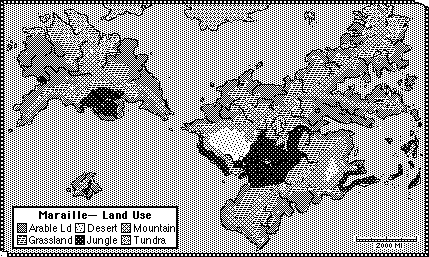 Maraille is a planet (circling the main star of p Eridani) in the Incatena, my sf universe and the setting for my novel Against Peace and Freedom. It's also a D&D campaign!
Maraille is a planet (circling the main star of p Eridani) in the Incatena, my sf universe and the setting for my novel Against Peace and Freedom. It's also a D&D campaign!
You can think of it as “Clarke's Law meets D&D.” Maraille is set in an sf universe with advanced technology— only it’s a medieval world. It has no magic, only high technology.
It’s kept that way by the powers that be— the Jondiles— based on the curious notion that certain desirable human traits are best nurtured in a stressful, low-tech environment. Most other planets are organized on the principle that human peace and prosperity should be maximized. That means, of course, that they're democracies run according the the latest findings of socionomics, using the latest technology, open to everything the galaxy has to offer.
But what if you need a general, or a ruthless soldier, or an assassin, or a scholar who understands the old religions because he lives them the old way, or a diplomat who can deal with primitive worlds, or even an actor who can truly embody a historical role because it's second nature to her? The usual answer is “special training”, but the Maraillais answer is “maintain two billion people in historical poverty and skim the population for skills we can use.”
Maraille isn't the only exception to the rule. Retrohabitats are fairly common in the Incatena: generally a space station or megahabitat where progress has been halted at the stage preferred by its occupants (or their ancestors), for religious or ideological reasons. Maraille is the only planet that's a retrohabitat; also the only one that's run by people who don't themselves want to live in the past.)
Campaign rules are in this color so you can ignore them.
The system and the planet
Languages
Political map
Religion
Aliens
FAQ
Or you can use it for a D&D campaign. That's its metanarrative origin, in fact. About 20 years ago, I was going to run a campaign— that would be AD&D v1.0— and prepared a HyperCard stack to both run the combat and give the background information.
The illustration above is from the original stack. It's a hassle to even run a HyperCard stack these days, but that pic makes me all nostalgic. This is what we had to do before color was invented. And that illo took most of the card, which in turn was a fair fraction of the original Mac screen. HyperCard motivated some severe chunking of information. It was so easy to get a stack going— design your cards, add text and pictures, add programming to make it do stuff. And then you'd always hit a wall as it was interpreted and huge stacks started to get slow.
I've heavily adapted that stack to make this page. Although I could use Javascript to re-create the combat calculations, there was nothing new in that and there must be a million tools out there (plus all I know is 1.0). I've added more setting information, and I encourage you to use anything else from the novel or the Incatena page.
This isn't really a module or a campaign… in fact, we never did start the campaign, so I can't even say these ideas are tested. That's why I call it an idea stack. But if you're the sort of DM I was, you can yourself handle turning an interesting set of ideas into a game session. (If you do, tell me how it goes!)
Campaigning on Maraille
Differences from D&D
Puvár (Power)
Powerlords
The system and the planet | ||
The exception is the Arabyah-speaking region, which uses the Islamic calendar. January 1, 4901 corresponds to 6 Shawwal, A.H. 4410.
Maraille was settled in 3252— that is, 1649 years ago. Keep that in mind when setting out ruins and lost items, and recall that population would have been low for the first few centuries. It's safe to make buildings, artifacts, writings, etc. up to 1400 years old.

It consists of two K stars orbiting each other at 30 to 98 AU, which is far enough apart that both could have planetary systems. Maraille orbits p Eridani A, which has the local name Solé.
Its binary Otsolé ranges from apparent magnitude of -15 to -17 (5 to 20 times brighter than the full moon, but nothing compared to the sun, which is -27). Corollary: when Otsolé is out, the night is not dark— you can easily read and walk around by its light. But it's not daytime.
Here's that link to the Incatena again, which provides background on what this interstellar civilization looks like (and the metanarrative on why it's that way).
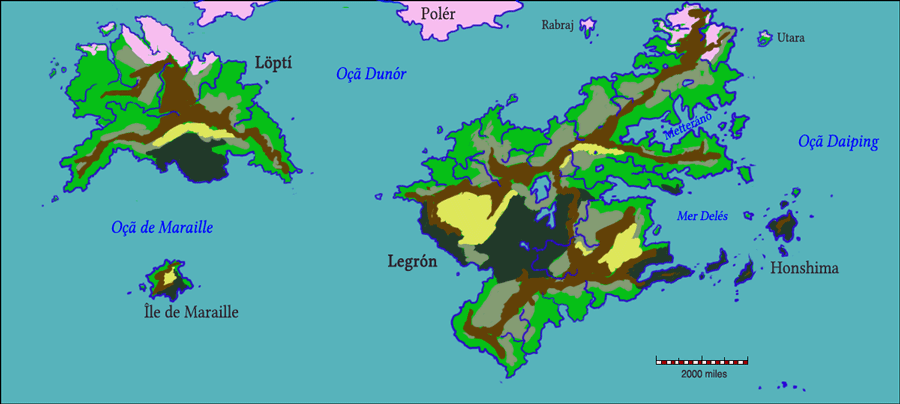
Maraille was settled in the 33rd century, from several nations, but led by the French (and their descendants on Novorossiya). Thus its name is pronounced mah-RIGH [ma 'raj]. Those who designed the colony, the Fondateurs, had a variation of the retrohabitat idea: they maintained that medieval conditions produced better people— hardier, smarter, more virtuous— but they had no desire to live that way themselves. They wanted to harvest the cream of the crop and take them into the Incatena.
The key fact about Maraille: Contact with the Incatena is limited to Île de Maraille. Here, about 25 million Maraillais live, with modern comforts. This is where the only spaceports are— and for that matter the only airports. The people of the Island call themselves gens de l'Île “island people”, which the rest of the planet turns into Jondiles. Offworlders in general are not allowed on the rest of the planet, except under escort; the nature of Maraille society is not generally known, as it violates the Incatena Treaty.
On the rest of the planet, including the oceans, high technology is forbidden. The cutoff is roughly AD 1450.
The map shows land use patterns rather than climate: light green for arable land, beige for grassland, yellow for deserts, brown for mountains, dark green for jungles, purple for tundra.
The circumference of Maraille is about 22,000 miles, a little smaller than Earth. (The diameter is 7000 miles.) The map omits a featureless section of the Oçã Daiping about 2000 miles wide. The map also omits the featureless south polar sea, and most of the boring northern continent, Polér.
Maraille did not have its own ecosystem, but it did have a pleasant climate and a carbon dioxide atmosphere. It was seeded with oxygen and terrestrial crops for about a hundred years before the first settlers arrived.
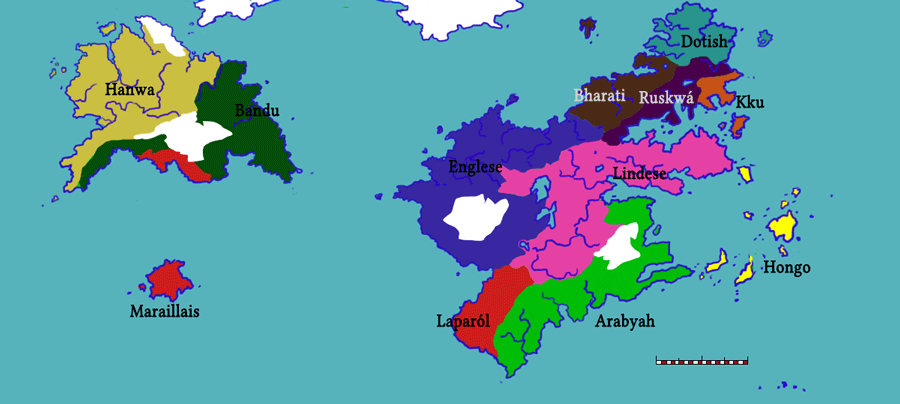
The languages spoken on Maraille, and their ancestors:
These are of course the 50th century derivatives of contemporary languages, which is why things are spelled weird on this page. The medieval situation encourages dialectization, and it can be assumed that each language area contains a wide range of dialects.
Englese English Lindese Spanish Arabyah Arabic Maraillais French Laparól French Hanwa Chinese Ruskwá Russian Dotish German Kku Indonesian Bandu Swahili Hongo Japanese Bharati Hindi
I've distinguished two French languages: Maraillais is a modern language which keeps in touch with other 50th century forms of French; Laparól is the primitive version, modified by a thousand years of medievalism and its own geographical context (e.g. it will borrow words mostly from Englese and Arabyah).
Maraillais speakers can speak Laparól. They study it in school and have experience in the Laparól regions. However, if they speak pure Maraillais among themselves, Laparól speakers cannot understand them.
The language map suggests the places of settlement of the original colonists, which was largely planned. Of course there have been major modifications due to war— e.g. Englese has expanded to the east at the expense of Bharati, and the Lindese have conquered quite a few Kku speakers.
Aliens (Skweeoo, Dzebyet, Garcheron) will of course speak their own language. Ogorodé do not have their own language.
Of course you will represent the language of your campaign area with English. (Or whatever you and your players speak.) Don't try to represent Englese with King James English— it's a language of the far future, not the past! However, you can use archaic English, if you like, to represent very old language materials.
Do please throw out all of the D&D stuff about alignment tongues, Thieves’ Cant, and other languages that wouldn't be present on Maraille. I also encourage you to make encounters with people of other language groups difficult. In real life, working with an interpreter is extremely cumbersome, and working without one is (for untrained people) nearly impossible.
It is extremely unlikely that players will know any alien languages.
If you need more names for your campaign… feel free to make them up. Believe me, there's a limit to how much conlanging you can impose on a D&D campaign. You may note that I've distorted the words to suggest future change, and you can follow my lead, but no matter how carefully you introduce "Mahmud al-Quds, Calif of the Qabili Saltana", your players will refer to him as "the bearded guy".
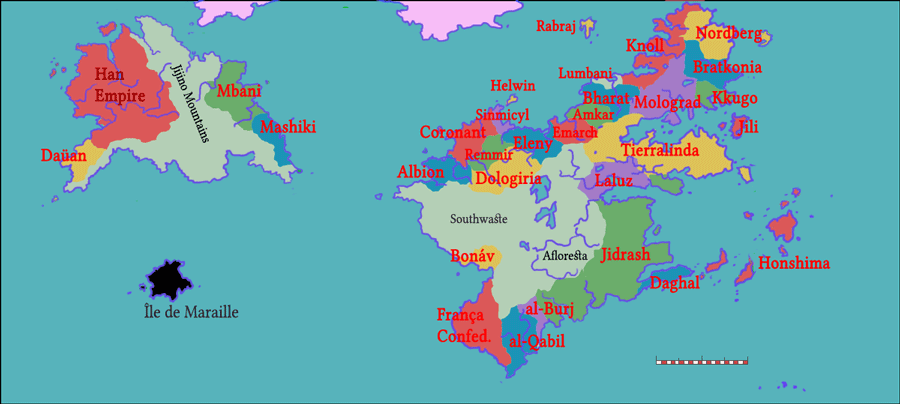
This map shows the major political entities. The very light color indicates unorganized territory, which of course is the best place to look for trouble.
The most powerful countries are these:
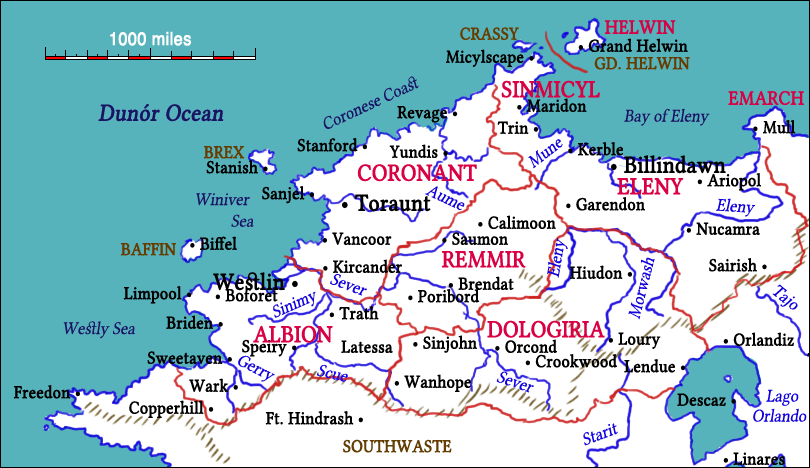
This is the intended playing area, though of course you are not restricted to it. All these countries speak Englese, except on the eastern edge where Lindese is spoken.
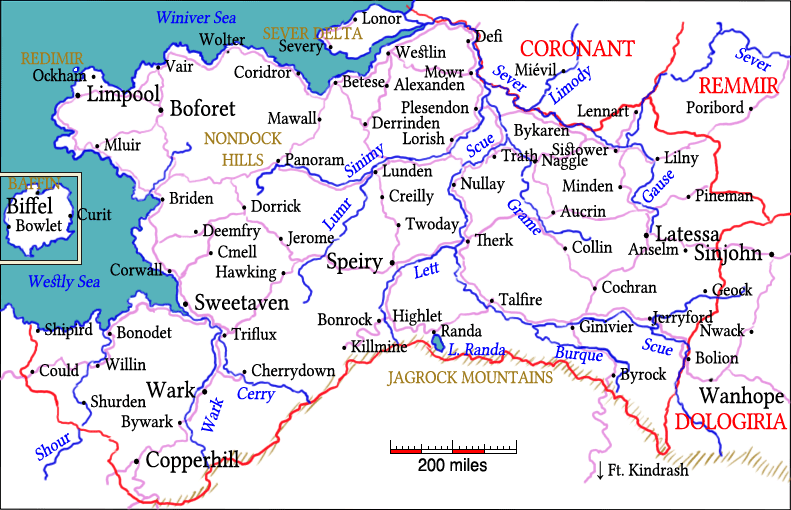
The campaign was going to start in Albion, so I have a map. It's a kingdom, with its capital and Parlmet at Speiry. It is not the strongest or richest state in the Englese sector— Coronant and Eleny are stronger. Its nobles, in fact, tend to resist any central control except in wartime. The Parlmet consists of the nobles, important religious leaders, and elected representatives of the towns.
The coastal cities of Westlin and Sweetaven are dense and self-governing, with a dizzying gulf between rich and poor— though the poor city dwellers, canny and grasping, are probably better off (though unhealthier) than the peasants in the countryside.
Named towns have at least 5,000 inhabitants— lesser villages and manor halls are not shown.
GMs: you should be a bastard about roads (in purple) and rivers. Travel should be two to three times faster along roads than in the open country, and crossing a river where there is no road (thus, no bridge) is a problem. Albionese would prefer river to road travel— though slower, it's far cheaper and safer.
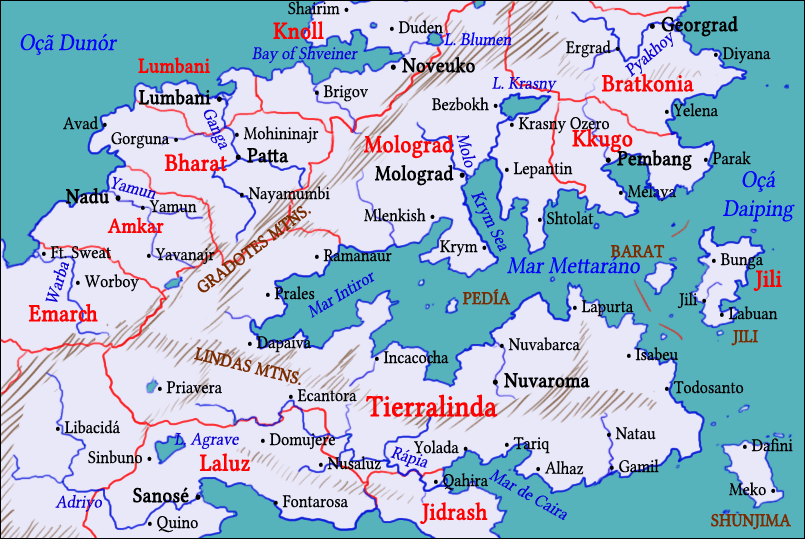
Notes on some of the countries to the east:
Catholicism The seat of Catholicism is the empire of Tierralinda, where the Patriarch of Maraille sits. Its official language is Lindese, which clerics above the parish level will have to know. See also the Catholic Orders. Unfortunately, the type of Catholics who settled Maraille were those who wished to return to a more authoritarian and patriarchal world. Only a minority are really zealous, but they try to make it hard for everyone else. On the other hand, Catholics believe in education, and their schools are often the best around. Catholicism is the commonest religion in Albion. Tunisianism This religion formed from a merger of Evangelical Christians and Muslims. It's rather stuffy about anything invented after the 40th century, but by our own standards it's progressive (e.g. it has no problem with homosexuality). It studies both the Bible and the Koran, worships Jehovah/Allah, worships on both Friday nights and Sundays, and celebrates both Christian and Islamic holidays. It views Muhammad as a prophet, and Jesus as something more than that— the precise theology is a dance of careful statements. Very interested in proselytizing outsiders. Anti-Tunisianism A motley collection of fierce sects which refused the Tunisian merger. They mostly pursue their own ideas of holiness, which differ from sect to sect and often from church to church. They do not proselytize. They are convinced that everyone else (including other Christians) are going to hell, but that's God's holy choice. Islam This is the religion of Jidrash as well as Kku, though since the first is Sunni and the second Shi‘a, they are really separated by a 3200-year-old feud. Maraillais Islam comes from The Future and accepts female equality; they consider the Lindese backwards. Shaivism One of the two major divisions of Hinduism, accepting Shiva as the chief god. They have merged with the Jains, and their priests are usually naked mendicant beggars. (This is not required for player characters.) They believe that the aim of life is to escape the cycle of rebirth through spiritual liberation, which comes from personal devotion to Shiva, who will take believers to his/her heaven. (Shiva has a female aspect, named Shri.) They tend to despise the Vaishnavites as bourgie pretenders. Vaishnavism The other division of Hinduism, accepting Vishnu as the chief god, or his avatars Rama, Krishna, or Mohini. Far more theological and less ascetic than the Shaivites, they believe that any sort of lifestyle can be managed in a holy way. Though they counsel devotion to Vishnu, they also maintain that the god is nir-guna “without attributes”. They disdain extreme asceticism such as that of the Shaivites. Buddhism This is a rough rubric for East Asian spirituality, common in the Han Empire as well as Honshima— it is a mixture of historical Buddhism, Dàoism, Confucianism, Shinto, and Communism. People accept whatever ideas and practices make sense to them and disregard the rest. Some belief in praying to gods, many don't. For those who wish to practice spirituality, there are temples where meditation, work, and reading are the chief avocations. Mirism Mirism derives from Novorossiya after our day, and is commonest in the Russian sector. Its name comes from mir ‘peace / world’, and it considers itself a high-minded, pacifistic, and rationalistic religion, although popular variants are more mystical— e.g. some adherants choose a personal deity or spirit animal. It emphasizes community (but distrusts authority), manners, and individual responsibility. People try to stay close to nature. Before Maraille was founded, Novorossiyan Mirists supported the project and many migrated to Maraille, eager to give up high technology. Noötheism This is the only religion that can claim to have been founded on the Vee, the Incatena's virtual reality network. It worships Mind as the aspirational deity of the cosmos, believing that the universe creates Mind, which when complete creates the next universe, in an eternal cycle. The Vee isn't available on Maraille, but a thorough denial of the importance of physical reality goes down well enough. Noötheists tend to be idealistic but individualistic, and great believers in mind-altering drugs. It is particularly common in the Dotish (German) sector.
In the cities one may encounter actual agnostics, or devotees of various schools of philosophy, from Social Vegetarianism to Chaotic Materialism.
The Ogorodé follow the dominant religion of the areas they find themselves in. The Jondiles rarely follow a religion, though some do so as a way of influencing the medievalists. The Dzebyet have their own theistic system; the Skweeoo are all atheists.
Clerics should choose one of these religions, or one that is likely to exist in the human future. No standard D&D paganisms or player-made ad hoc religions. Players should be expected to follow the morality of the given religion in order to gain their spells. I would discourage “too magical” spells, or require that they be cast using Objects of Puvár.
They are very conscious of community and social issues, and are likely to seek out other Medellinians to accomplish some good mission. They may not accumulate wealth, nor be friendly with the rich— and lords do not look so kindly on them either, as they interfere with what the lords call “how I choose to run my domain.” They do not get along well with Inquisitors or Picarians.
Jesuits are organized very strictly, and every Jesuit will have a spiritual director to report to (the Master of the Order reports to the Patriarch, of course). Disobedience to one's director is a serious crime, and it isn't yours to reason why (unless the director suggests an action contrary to the expressed direction of the Patriarch).
Unlike Medellinians, Picarians are individualistic in temperament, and once an evil is corrected they tend not to stick around— they ride off into the sunset to look for other causes. They are also more concerned with individual rather than social morality— they will go rescue the kidnapped daughter of a liege where the Medellinian is more likely to seek redress for the liege's downtrodden peasants.
They may make temporary alliances with non-Catholics, but only to advance their own missions or goals. They are harsh with what they consider sinners, they prefer the authorities to those they rule, and they despise Medellinians. They tolerate Picarians, but they have age-old grudges with Jesuits.
These are detailed to offer more local color for clerics, and so players do not treat the Catholic church (dominant in Albion) as a monolithic entity. A player's Order should affect local politics, what alliances are possible, how NPCs react to them. It should also replace “alignment”. Spells that deal with “good” should be interpreted as “good according to the values of the cleric's Order.”
The most common will be Ogorodé, a species of small, easily overlooked omnivores, who take the jobs no one else wants to do… a social niche which has allowed them to spread to a thousand planets. (By comparison there are fifty human worlds.) The Fondateurs had not planned to include them, but a few made it to Maraille, and they are too useful to give up.
I suggest you use Dwarves as the model for Ogorodé… but their basic personality should fit the above description. For D&D campaigns, I gave them (and no other species) the power of telepathy. Mining would be only one of the nasty jobs they are willing to take. They have no beards, much less artfully braided ones.
Skweeoo are large and hard to kill. To save time you could model them on orcs, though you should not think of them as brutish nor as warriors. They are highly intelligent and rationalistic and come in three sexes.
Dzebyet look like little blue monkeys, about four feet tall. They have been civilized for about 90,000 years, so they consider even the Jondiles to be amusing savages. As they are highly advanced and very dextrous, you might model them on elves.
The latter two species should be very rarely encountered. They were not among the settlers of Maraille. NPCs of these species, or players, should have a very good reason for leaving the Île de Maraille, and a story for why the Jondiles either allowed this or didn't catch them. (Scholarly research is always a good dodge.)
However, it is a mere pittance by Incatena standards of age. By contrast, Jondiles live over 400 years; Dzebyet live to 300; Skweeoo can last thousands of years, but as their brain cells slowly regenerate their memories only go back a thousand years or so.
A Jondile matures sexually at 19, and is done schooling by 40 or 50, at which point an ordinary Maraillais will mistake him for a young man of 30. He will look indefinably "middle-aged" till about 100, then "Jondile old"— different than a middle-aged human (the years do not slide by with no effect, after all), but not somehow old-looking. Even when a Jondile hits old age (375-450), the symptoms are different than for normal old age. For instance, the skin tends to become glossy rather than parchmenty, and the characteristic disabilty is plumpness, not emaciation.
Ogorodé, approximating as usual to local conditions, live to about 60.
Campaigning on Maraille | ||
General differences:
For later campaigns you could allow alien or offworlder characters.
Some campaign ideas:
Investigate a ruined building rumored to contain an Objet of Puvár.
The local noble wants help against a bandit gang said to have a weapon with Puvár.
Save your town from an interfering Inquisitor.
A pack of dinosaurs from the jungle threatens your region.
You hear of an interesting invention, and hear that the Jondiles want to shut it down.
An alien crash-lands nearby and wants an escort to the nearest big city.
There must be some good loot (but also hard enemies) at one of the Schools of the Puvár.
Your offworlder research station is attacked by bandits.
An industrial accident has released mutagens, and you need to fight or capture the mutants.
Out in the Southwaste there is said to be a treasure trove (the fabled Research Station).
An assassin has a cloak of invisibility and is out to assassinate the king. Or one of your party.
A Medellinian has an interesting plan on how to overthrow the Tyrantess of Dologiria.
You are from Île de Maraille and need to confiscate several overpowered Objects of Puvár.
Your offworlder party crashes in the wasteland.
You're an Incatena Agent, assigned to hire the best assassin in Toraunt for the Agency.
It's suspected one of the Fondateurs still lives.
The Incatena wants to eliminate slavery. Play as the Incatena Agents or as the Jondiles resisting them.
To be clear, there is no Puvár; it is not The Force. But under the conditions of Maraille it is inevitable that such a concept would develop.
Professors usually deny and disparage the Puvár; clerics of most religions reject it. If something seems inexplicable, the authorities say we should just defer to the superior understanding of the Jondiles.
But the commoner can hardly be kept from positing some kind of supernatural explanation for unusual things— the Puvár. Others go further, and claim to possess an understanding or mastery of this unknown force. These are the Puvarö, or in plain Englese, Powerlords. They accumulate objects with Puvár, they theorize about the magic forces inside them, they combine these with incantations, special drugs, meditation, mesmerism. They are the occultists and Forteans of Maraille… except, of course, no one can prove them wrong, and it's obvious that the Jondiles do have powers which the professors cannot explain. The layman gives them a wide berth.
Powerlord skills
Obviously, the most effective source of Puvár are actual Objects of Puvár. A Powerlord will have at least one, and will seek assiduously to acquire more.
The source of Objects is of course Jondiles or other offworlders. They would hardly think of going to the mainland without a stock of equipment. Inevitably some items will be lost or stolen… or smuggled out.
The more powerful items are subject to immediate confiscation by Jondile agents. Naturally they will respond to reports of use in public in towns; use off in the wilderness will be harder to track down.
The Objects are rarely very large— you won't find volants, ground transports, battleships, helicopters, or terraforming equipment. Such things would be hard to smuggle and impossible to hide.
There is also Incatena technology that by its nature cannot be smuggled into Maraille in any transferrable way; however, offworld or Jondile characters might have these:
Obviously, objects of Puvár should be difficult to obtain, and described as they would appear to the medieval Maraillais. It is also important to keep them rare. A major appliance is a treasure worth fighting battles over, and an array of half a dozen of them would be a king's horde. If a party is known to possess one, the avarice of others will be awakened. They are not available in stores (though perhaps very minor items like bandages are).
Treat Objets of Puvár as more durable than their present-day equivalents (if any)… but not ridiculously so. Many are electronic or photonic, and will not deal well with immersion, burning, etc. Maraillais would of course have noticed this, but may not know everything that can harm their Objects.
Some items may require replenishment (ammo, printer supply blocks…) or can be used up. But for the same reason these can be more safely handed out to players.
Objects of Puvár, including their Maraillais name, are given below. This is not an exhaustive list! Think of useful, portable objects available now or in the Incatena future.
AI (talking box)
anesthetics (unfeeling potions)
antibiotics (curing potions)
antidote for Maraillais poisons (protecting potions)
antiseptic bandages (Jondile bandages)
artificial limb (metal arm/leg)
baro riot control dust (disabling potion)
battle laser (large lightning-hand)
calculator (metal abacus)
chainsaw (living ax)
chemical poisons (killing potions)
crewsuit (Jondile leather)
electric whip (shocking whip)
electronic book (talking book)
energy screen (Powerlord's shield)
fiberoptic rope (light-bending rope)
fireworks
flare (shooting star)
flashlight (heatless torch)
fusion heater (firebox)
GPS device (wayfinder)
grenade (boomapple)
gravity adjuster (rods of lightness)
heating element (heating rod)
IIC infantry suit (Jondile battle armor)
jetpack (backpack of flight)
laser pistol (small lightning-hand)
lightbending suit (cloak of invisibility)
lie detector (truth box)
max gun (multi-ball hand cannon)
mec (metal man)
microwave oven with energy shield (magic plate)
nanoduper (cornucopia)
nanoscanner (rod of discernment)
nutrition supplemnt (Jondile rations)
pasta maker
pen (inkless plume)
plasmator (lightning cannon)
plastic clothing (Jondile cloth)
plastic explosives (fire-earth)
power source (Power stones)
pressure suit (Jondile light armor)
projectile pistol (hand cannon)
radioactive powder (dazzling powder)
recharger (Puvár dispenser)
refetalizer (limb maker)
space scooter (iron horse)
spark generator (dazzler)
telephone (rod of distant communication)
telescope (seeing rod)
tracking device (trailer)
translator
volant (flying wagon)
water purifier (magic jar)
wristwatch (wrist clock)
Jondile light armor is a light bodysuit of a plastic-like material, a standard-issue military uniform, durable and resistant to body blows and, due to a built-in metal mesh, to blows from edged weapons. It provides little or no protection against gunfire or lasers. Some versions are pressurized.
Jondile battle armor is a metallic pressure suit, which resists blows, bullets, gas, lasers, heat, water, radiation, and vacuum. It is by no means impermeable: it can be punctured by sufficient force. In an actual 50the century military situation its major use is to protect against the environment (e.g. space, poisonous gas, radiation), not against weapons… contemporary weapons will generally kill you no matter what you're wearing. In police situations or on Maraille its protective ability is good, however.
Aliens cannot wear human clothing/armor, and vice versa!
They generally study the Puvár with tutors or in schools. Tutors were themselves trained somewhere; every Powerlord ultimately owes their “Puvarology” to a particular school, though they may or may not acknowledge this. (Still, it's useful to have allies.) The major ones:
Dunwich in Mowr, AlbionThese require knowing the appropriate language, of course.
Strom College in Loury, Dologiria
The Bell and Bowl in Calimoon, Remmir
Lar Sekrè in the França Confederacy
Lun and Hanlin, in the Han Empire
al-Sirr and al-Qudra, in Jidrash
Püvartektik in Knoll
Nayan in Bharat
Shkol Nauk in Molograd
Colegio del Poder and El Yonosé in Tierralinda
Powerlords are intended as a rough equivalent of magic users, and should have the same sort of attribute requirements, hit points, level advancement, etc. I would allow them ranged weapons just to keep them useful.
They begin with one Object of Puvár. A good one, please… something that would give the first-level Powerlord something of a reputation, and usefulness in a first-level party.
You should not give Powerlords spells! Rather, structure quests to give them Objects of Puvár as rewards.
I've also created a list of Powerlord Skills to give them more things to do.
You might give a Powerlord one to begin with, and require them to research others.
If application details are not given, treat the Skill much like the old Fallout 3 skills. That is, your skill is a number from 1 to 100. A beginning character might be given a skill value of 10. Then roll a d100 to see if the skill solves the situation.
Skills do not stack— use the best one that applies to the situation. For some of them, it would make sense to allow the player to take multiple ranks in that skill for extra benefits.
If successful, the player will be able sense the mood of the animal and (if it was not actually hostile) influence it in a friendly direction.
In combat, this anticipation, plus the use of some confusing gestures and sounds, is enough to reduce the animal's to-hit roll by 1.
To reflect an Athlete's consummate bodily skills, treat him as fighting one level above his actual level, and keep in mind the above discussion.
Powerlord healing is most effective with combat wounds, less so with diseases or degenerative conditions.
Some Jondile supplies are common enough that they are not considered Objects of Puvár, though you won't find them in the village market: painkillers, wound ointments, bandages, wound spray. If the player has such things available you can add +30 to their roll.
If someone has this skill, you can let them bring a bag of herbs along— they should specify the types and numbers of doses. They either have the herb they need, or they don't. The numeric roll can be used to see if they can find any good herbs in an hour's search.
Some local herbs (not an exhaustive list):
alcohol— depressant and anti-inhibitory for d8 hours; easily bought
antivol— will suppressant; available from Powerlords or Jondiles
belladonna— strong poison; sold in herb stores
Bharati pepper— extremely hot pepper; powdered, can be used offensively
bitterbalm— delays death; grows in plains, forests
cocanis— strong stimulant from the rain forests
coffee— mild stimulant; easily bought
comfrey— healing effects d4; grows in moderate climates
dorwort— suppresses sex drive and pregnancy; grows in mountainous areas
marijuana— stimulant d4 hours
mustard— emetic; readily bought
peyote— hallucinogen d8 hours; grows in desert, can be bought
soma— euphoriant, grown in Bharati areas
scorbo— trance inducer; herb shops
sweetbalm— healing effects d4; found in forests and jungles
tea— mild stimulant; easily bought
tokornis— true aphrodisiac; prostitutes or Powerlords may sell
wilimar— anesthetic; grows in plains
Player characters cannot be Mesmerized.
Applied to NPCs not in combat, roll at three times the skill level. E.g. if your skill is 10, your chance of influencing the subjeect is 30%. The GM can modify this based on the outrageousness of the suggestion.
The Powerlord may also attempt it in combat, in place of any attack. If successful, the creature is confused and loses their attack that round.
It operates at a penalty in a town not known to the player.
In combat, it consists of special knowledge of combat moves, places to apply damage, and environmental advantages. It increases one's to-hit roll by 1.
(If you want a natural explanation, it's that all brains transmit electromagnetic waves, and Ogorodé ones all the more so. Natural science cannot decode these transmissions, although it can detect them.)
The Ogorodé use this ability on a natural level to build consensus, to speak only what will be well received. They tend to have passive, inobtrusive personalities: it's hard to get one to argue with you. They naturally assume a helpful, subservient role in society, using telepathy to make themselves pleasing, avoiding all controversy and wordly ambition, absorbing the religions and languages of their hosts. It may or may not be noble, but it has insinuated them into dozens of alien cultures, and sustained their own, on their own terms.
Ogorodé can read surface emotions of humans, animals, and other races. They can read and project surface thoughts if they directly touch the subject.
Telepathic abilities are automatic, and do not vary by level or by a skill rating.
There are no forms of telepathic attack. In addition, the skill does not allow psychic probing— even touching the subject, you can only tell what they are thinking, not search their memories. (This is because it monitors electrical activity, not neural configuation.)
In combat, telepathy gives a sense of what a creature will do next, allowing avoidance. Treat this as a -1 on the creature's to-hit roll.
